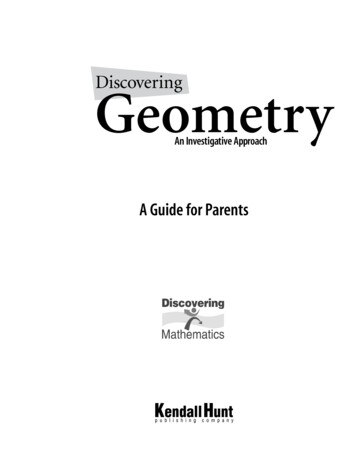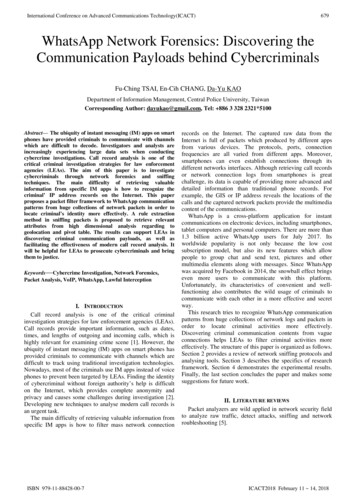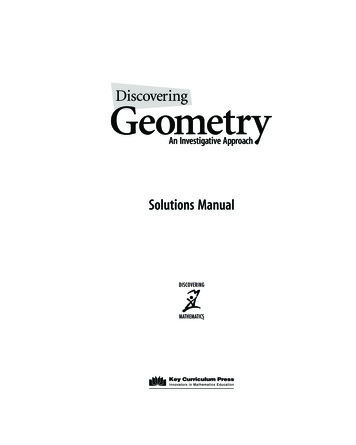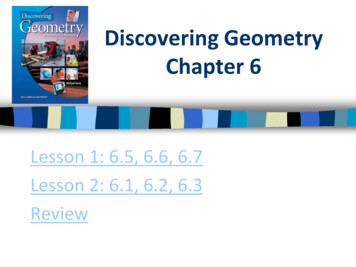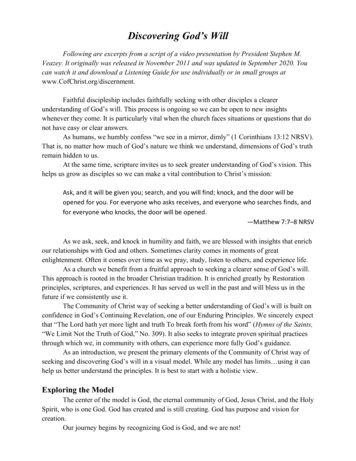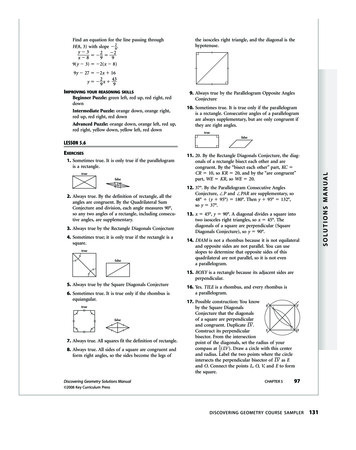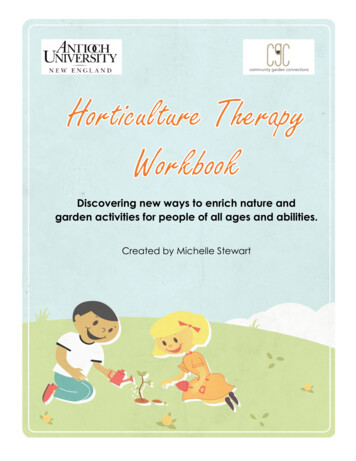
Transcription
Discovering new ways to enrich nature andgarden activities for people of all ages and abilities.Created by Michelle Stewart
Horticulture Therapy WorkbookAcknowledgementsThis workbook was created in connection with Community GardenConnections (CGC). It was designed to serve as a reference abouthorticulture therapy and as a guide through the process of creatingsuccessful horticulture therapy activities and programs. This workbook isto be used by CGC, CGC sites, Antioch University New England students,community partners, and other interested individuals.Lead Author: Michelle StewartPhotos/Graphics: All photos are public domain, used by the permission ofthe artist, or otherwise credited.Copyright Information: This manual was written and copyrighted byMichelle Stewart in fulfillment of academic requirements. It is intended fornon-commercial educational purposes only, and may be freelydistributed, reproduced and used for such educational purposes withattribution of authorship to Michelle Stewart and Community GardenConnections. Any modification or other proposed use requires writtenconsent of the author. 2016 Michelle Stewart2
Horticulture Therapy WorkbookTable of ContentsWhat is Horticulture Therapy? . 3Who Benefits from Horticulture Therapy? 4How to use Horticulture Therapy . 5How to Create a Horticulture Therapy Program . 6Peer Support and Horticulture Therapy . 9Therapeutic Garden Design . 10Ideas for Horticulture Therapy Activities . 12Appendices:A: Action Plan . 27B: Action Plan Examples .28C: Activity Plan . 31D: Therapeutic Garden Features .32E: Wheelchair Accessible Garden Beds 33F: Other Easy Activities . 34G: Sensory Plants .35H: Plants for Container Gardens .36I: Using Horticulture Therapy for Mental Health . 37Resources and References 413
Horticulture Therapy WorkbookWhat is Horticulture Therapy?Horticulture therapy is the use of plants and the natural world to improve thesocial, spiritual, physical, mental, and emotional well-being of individuals whoparticipate in it.There are three types of horticulture therapy programs: vocational,therapeutic, and social. Vocational programs work to develop skills and characteristics that will leadto employment. Can include rehabilitation as individuals recover from injury,illness, or disability. Therapeutic programs are designed to assist with recovery with the goal ofwholeness and healing. Social programs are focused on gardening as a leisure activity that supportsgeneral well-being.1Horticulture therapy can take place in many different settings, both indoorsand outdoors. From digging in a garden, to sitting on a bench in a park, toworking with potted indoor plants, to walking in the woods, to doing activitieswith a licensed horticultural therapist, and many more.It can also be adapted to many different people and their needs and abilities.Horticulture therapy can be an individual activity or a collaborative pes.orgHaller, R. (1998).4
Horticulture Therapy WorkbookWho Benefits from Horticulture Therapy?We all benefit! Horticulture therapy can be used with any audience, no mattertheir age, knowledge, physical or mental ability.Gardening and spending time outside can have many positive benefits for ourmental, physical, social, and emotional health. Outdoor activities can improvemood; lessen depression, anxiety, loneliness, and stress; increase self-esteem;speed disease or illness recovery; and promote a sense of community andconnectedness.Horticulture therapy is a flexible practice that can take place in any settingthat involves plants or nature. It can be anything from a private meditation, toworking in a garden with family or community members, to a class project foryouth, to a group activity at a retirement facility.While we all benefit from exposure to nature, there are certain groups whocan especially grow and thrive when using horticulture therapy techniques: Those with ADD/ADHDThose with autismThose who are physically or mentally disabledThose with major or minor health issueso Includes cancer, stroke, brain injury, amputation, Alzheimer’s anddementia, surgery of any kind, and more.Those with mental health and/or stress issuesThose who are at-risk and/or in juvenile detentionThose who are prisoners or on paroleThose who have experienced abuseThose who are refugeesThose with addiction or those who are in addiction recoveryThose who are veterans of war (PTSD, trouble adjusting, etc.)Those with arthritis and/or other physical ailments of aging5
Horticulture Therapy WorkbookHow to use Horticulture TherapyHorticulture therapy (HT) techniques are employed to assist participants to learnnew skills or regain those that are lost. HT helps improve memory, cognitiveabilities, task initiation, language skills, and socialization. In physical rehabilitation,horticulture therapy can help strengthen muscles and improve coordination,balance, and endurance. In vocational HT settings, people learn to workindependently, problem solve, and follow directions.–American Horticulture Therapy AssociationHorticulture therapy can be used to learn social, vocational, and life skills;teach math, science, art, etc.; improve or regain physical abilities; work offexcess energy; communicate emotions; share stories and knowledge; provideprivacy and escape; and make connections. And that’s just the beginning!It can be active (physical activity and/or changing surroundings) or passive(less physical activity and/or not changing surroundings); designed to fit theability and needs of the participant. Active activities include gardening,running/walking, etc., while passive activities include sitting on a bench,drawing, meditating, etc. It can also be an individual activity or a groupundertaking—the possibilities are endless.The main benefits of horticulture therapy are as follows: Nurturing; connecting;grounding; imparting purpose and ownership; physical and mental health; skillbuilding; reflection; and providing distraction, privacy, escape, and security.Discover the benefit that you or the participant wants to receive and use thetherapeutic space to design an appropriate plan and/or activity that will helpyou or them succeed (for more information see pages 5-7).Especially consider how to use nature and its processes to your advantage.Ideas like change, patience, planning, attention, direction, hope, potential,and even death are all connected to nature and gardening, and can beused to have important discussions with people of all ages.See Appendix I for specific mental health connections.6
Horticulture Therapy WorkbookHow to Create a HorticultureTherapy ProgramThe following section delves into the process of creating a horticulture therapyprogram. It will be written from the perspective of an individual trying to helpsomeone else capture the benefits of nature, however, these ideas can alsobe used on a personal or peer support basis as well (see next section on PeerSupport). You can easily use these steps to set goals, make a plan, and createactivities as a group or for your own personal benefit as well.Anyone can lead horticulture therapy activities, just use these basicguidelines!21. Learn about the participant. While you do not have to be a certifiedhorticulture therapist, it is often easier if you are knowledgeable not onlyabout the participant’s illness, issue, and/or disability, but also about theparticipant as an individual. This will make developing activities andadaptations that are appropriate and accessible for the user mucheasier, and it will improve your chance of success.If you aren’t as knowledgeable about these topics, seek guidance fromothers who would know the participant and create a treatment team.For example, members of the treatment team could include doctors,caregivers, therapists, family members, social workers, and even theclient.For example:Name: Jane SmithAge: 18Area to work on: Recover from recent knee surgery, improve depressivesymptomsTreatment Team: Jane, Dr. Blake (Jane’s primary care doctor), Dr. John (Jane’sphysical therapist), Dr. Stark (Jane’s therapist), and Jane’s parents.Hobbies: Sports, watching movies, and drawingDislikes: Spiders and cooking2Adapted from Haller, R.L. & Kramer, C.L. (2006).7
Horticulture Therapy Workbook2. Create treatment goals. Once you have learned about the participantand her/his areas to improve you should work with them to set specificgoals to address these topics. Goals are generally long-term and arefocused on achieving something through multiple steps (ex: Successfullyeat a meal without assistance; obtaining employment; managing stresseffectively at work, etc.). Use the idea of SMART goals to make Specific,Measurable, Attainable, Realistic, and Time-bound goals. Primary goal areas:o Physical: improve fine motor skills, gross motor skills,standing/balance and endurance, mobility, range of motion, andstrengtho Cognitive: speech and vocabulary, memory, learn new skills,sequencing, follow directions, problem solving, and attention totaskso Emotional: improve self-esteem, safety, control, care, reduce angerand aggression, lower stress, improve outlook on life, and increasespiritual connectiono Sensory stimulation: connects to cognitive and emotional goals—oftentimes the senses will awaken memories or experienceso Interpersonal/Social: enhance family visits, increase connectionand conversation with others, share experiences and memories,and cooperate with otherso Community integration: Increase involvement in community groupsor clubs, and discover job opportunities3. Using the treatment goals, create an action plan. Include detailedobjectives or short-term goals, actions to be taken, and plans for how tomeasure outcomes (See Appendix A and B). Components of an action plano Objective: A precisely worded statement of what is to be achieved withina short timeframeo Methods: Who will do what, how, under what circumstances, where,when, and how often; includes what the therapist will do, the strategiesfor interventiono Criteria: Quantifies achievement of objective, i.e. how much, how many,how often, how well8
Horticulture Therapy Workbooko Documentation: Outlines who will measure, what will be measured, howoften, and where or how it is recorded4. Develop activities and/or therapy sessions. Consider the participant andher/his goals and objectives—what do they want to achieve? What aretheir limitations? Strengths? How can a garden, plants, or an outdoorspace help? (For activity ideas see pages 11-25 and Appendix F) Create an activity that is age and ability appropriate for the participant—they should leave feeling positive about their progress andaccomplishmentsActivities that require minimal intervention or support by the therapist andmaximize independence of the client are the most effectiveAlso, consider available resources. How much time, money, space, andstaff do you have to work with?5. Lead activities and/or therapy sessions. Follow the activity plan youcreated for the participant and document outcomes (See Appendix C). Adapt or modify the activity if it is too much of a challenge. Considerchanging the length of time, difficulty, or g9
Horticulture Therapy WorkbookPeer Support and Horticulture TherapyPeer support is a system of giving and receiving help founded on key principlesof respect, shared responsibility, and mutual agreement of what is helpful. It isabout understanding another’s situation empathically through the sharedexperience of emotional and psychological pain.3This form of recovery and growth is not based on psychiatric models ordiagnoses—there is no clinically-trained therapist involved. Instead of anexpert-patient relationship there is connection, mutual experience,understanding, and support given and received by others with similarexperiences and situations.The peer support model and be easily connected to horticulture therapy.However, unlike the steps to create a horticulture therapy program above, ahorticulture therapy program based on peer support would be created byand for the participants. As a group or individuals participants could looselyfollow the steps above to create goals, design an action plan, and developactivities to help them achieve those goals.In the peer support model, participants would be responsible for seeing theirown plan through, but would be supported by the other members of thegroup. However, some of the activities chosen could be group-based, andparticipants could tap into the community-building aspects of horticulturetherapy to make connections and support one another.Along with this, a therapeutic outdoor space would be a great setting for peersupport to take place. Therapeutic spaces can often provide a calming,serene environment that people can feel comfortable and secure in, evenwhen talking about difficult subjects. Nature and being connected to theearth can often succeed at putting issues and problems into perspective andopen the door for new discoveries.3Mead, S. (2003).10
Horticulture Therapy WorkbookTherapeutic Garden DesignEntire books have been written on the ins-and-outs of therapeutic gardendesign (see References for more information). Follow these general steps tocreate a garden space that can be used by all.First, when starting a therapy garden consider your audience and theirneeds and then get them involved! Use a participatory design model to askusers what kind of space and features they want. For example, providepictures of garden images or feature ideas and let people vote on theirfavorites. You will have a much more successful program if you ask the peoplewho will be using the space what they want and/or need.Next, depending on the users of the garden space it could also be importantto talk to other professionals like doctors, architects, landscape designers,occupational therapists, psychologists, care providers, etc. They can providevaluable insights into the needs and abilities of the participants from aprofessional point of view.Then, using their input and/or support, design a space that will work best for allusers. Universal Design ensures that an environment will be usable by thewidest range of users regardless of age, ability, culture, or preference (Figure1). Make sure you design for freedom and privacy, but also for safety. Trydrawing the garden space from above for a new perspective.Next, install the natural and physical features decided upon, and if possiblemake it a participatory event (See Appendix D for feature ideas). Whetherparticipants wanted potted indoor plants, wheelchair accessible raised beds,or an extensive flower garden with walkable paths, get them involved in thebuilding and installation processes.Finally, get creative! Come up with fun activities that will help participants usethe space and gain the skills that they need to succeed in their therapyprograms (See pages 11-25 and Appendix F). Don’t hesitate to ask participantsif they have any ideas for activities!11
Horticulture Therapy WorkbookSeven Principles to GuideTherapeutic Garden Design1. Equitable use: the garden is appropriate andappealing for all without segregating orstigmatizing others2. Flexibility in use: the garden is adaptable to awide range of individual preferences and abilitiesand provides choices to accommodate them3. Simple and intuitive use: the garden is selfexplanatory; there is not excessive energyrequired to know who and what to do in thespace4. Perceptible information: The design itselfeffectively communicated important informationregardless of a user’s sensory capabilities5. Tolerance for error: Features of the gardenminimize hazards and the possibility of errors. Itprovides failsafe features6. Low physical effort: the appropriate level of effortis expended to be in and use the garden7. Size and space for approach for use: the gardenis manageable to be in for all, regardless of bodytype or mobility status. There are clear lines ofsight, reachable components, and adequatespace.Figure 1: Winterbottom, D. & Wagenfeld, A. (2015). Therapeutic Gardens:Design for healing spaces. Timber Press, Inc. Portland: Oregon.12
Horticulture Therapy WorkbookHorticulture Therapy Activity IdeasMost of these activities are universal, however, particular populations thatcould especially benefit have been noted.Remember to consider the abilities of the participants when planningactivities. Digging: Youth (Autism, ADD/ADHD) . 13 Planting: All . 14 Nature Treasure Hunt: All 16 Guess Who: Youth (Autism, ADD/ADHD) . 17 The Bean Icebreaker Game: Youth (ADD/ADHD) . 18 Flower Power: Youth . 19 Can You Hear What I hear? Youth (ADD/ADHD) . 20 Mini Soil/Sand Box: All (ADD/ADHD; autism; mentally disabled;physically disabled; wheelchair bound; stroke) . 21 Support: Youth (at-risk, addiction recovery); Adults(incarcerated, addiction recovery) . 22 Bird Feeders: All . 23 Nature Collage or Memory Box: All 24 Floral Arrangements: All . 25 Exploring Scents: All . 26For more ideas see Appendix F13
Horticulture Therapy WorkbookDigging4Population: Youth (Autism, ADD/ADHD)Aim: Introduce participant to soil; reduce and redirect aggressive and hyperbehavior; lower anxiety; reset mood; physical activity; hand-eye coordination.Tools: Shovel or hand trowel Digging plot, sand box, or a container of soil or sandThe Activity:Bring your student to the digging plot and let them pick their digginginstrument.*Encourage the student to start digging in the digging plot, and let them dighowever they wish. Be open to the child’s digging methods and actions. If s/hewants to lay down, to taste or smell it, let them do it and then ask them whatthey experienced. Follow their lead. This is all part of learning through play.Beyond exercise, this is a great activity to start discussing and learning aboutsoil. What does it look like? Feel like? What else can they see? Are they findingrocks? Worms? React positively to all discoveries and encourage the child toshow their finds to classmates or family members. This shared experience canbuild self-esteem and teaches a basic social interaction skill of sharing.Always start your day in the digging plot. Routine repetition is especiallyimportant for children with autism. Use digging as a motivator, not punishment.*Note: If you are worried about aggressive tendencies, use a garden hand trowelinstead of a shovel and never turn your back on the student.4Adapted from Etherington, N. (2012). 30-32.14
Horticulture Therapy WorkbookPlanting5Population: AllAim: Physical activity; dexterity; hand-eye coordination; following directions;flexible thinking; making predictions/considering the future; plant life cycles;hope; growth; connection to the earth; responsibility; teamwork; exploringactions and consequencesTools: Seeds or plants. Consider purchasing large seeds (ex: sunflower,pumpkin) and durable plants (ex: small trees, ornamental grass)depending on age and ability of participants. Container/plot for planting. Can be in the ground, in a pot, or in anotheritem like a bucket. Remember to always punch or drill holes in thebottom for drainage. Potting soil Water and a water bottle or watering canThe Activity:When planting there is a set sequence: Container: Add soil to the container until it is 2/3 full, place the plant inthe container on the soil, water plant, add more soil until the plant isproperly covered. Ground: Dig a hole two times the size of the plant and its roots, placeplant in hole, water, fill in hole with dirt or compost.Demonstrate for participants first. Walk them through the steps you’re takingverbally so they understand what you’re doing and why. And then let them try!This is a great activity to teach directions and learning sequences. Be positiveabout what they do.Let the participants have their own container, own small plot, or have themwork together to plant seeds. Label containers or plots with their names so theycan watch the seeds’ progress. Encourage them to journal along as the plantscome up and grow—how does this process connect to their lives?5Adapted from Etherington, N. (2012). 37-38.15
Horticulture Therapy WorkbookPlanting ContinuedIf participants planted in a container you can let them take the pot at the endof the day, or it can be left in the garden. If the plant is in the ground makesure you bring them back to check on its progress regularly.Follow up about the seeds’ progress. Did the plant come up? What does itlook like? What will it need to thrive and succeed? If plants don’t come up talkabout why this could have happened. Discuss optimal growing conditions.Explain that even though we did all we could to provide optimal growingconditions, through either weather, planting depth, etc., our plants did notgrow as well as expected. We learn that the consequences of our actions arenot always predictable. Accepting change is very hard. We watered the plantevery day, so why did it die? Ask what could we do differently next time? Lookfor a solution together.*Note: Look at the back of each seed packet for planting instructions. There you willfind useful information (ex: how deep to bury the ymouthmag.com16
Horticulture Therapy WorkbookNature Treasure Hunt6Population: AllAim: Plant recognition; teamwork; physical activity; communication; seasons;changeTools: Laminated Sheet Dry Erase MarkersThe Activity:Go around the grounds and/or garden and take pictures of various plants andfeatures. Using a computer, place the images in 4x4 or 5x5 squares, similar to abingo card. Make sure that all of the sheets are a little bit different and includedifferent images. Print and laminate.Encourage participants to find a buddy and have them go on a naturetreasure hunt together. Can they find all of the images on their card? Whatelse did they discover along the way?This activity can be completed at many different times of the year. Simply takepictures during each season and make special seasonal treasure hunt sheetsfor each season. Have participants discuss why certain plants look differentduring other times of the year. Why do they change? Can discuss plant lifecycles depending on ability and age of participants.You can also look online for already designed nature scavenger hunts.6Adapted from Etherington, N. (2012).17
Horticulture Therapy WorkbookGuess Who7Population: Youth (Autism, ADD/ADHD)Aim: Use multiple senses to guess identity; teamwork; asking for help; sharingTools: Paper bags or tote bags Seeds (use larger seeds) Plant cuttings (preferably ones with a unique texture or smell)* VegetablesThe Activity:Place the items in the bags before the participants arrive.Divide participants up into pairs. Give one person the bag and ask them toclose their eyes or put on a blindfold (depends on individual comfort). Askthem to take one item out at a time and guess what it is. They can smell, feel,and taste the item.*If they are having trouble guessing, they can ask their partner for help. Thepartner can describe the items features (ex: color, shape, etc.), but should nottell their partner the item’s name.After they have guessed correctly they should pass the bag to their partnerand the process begins again.*Note: Make sure that the items you have chosen are all non-toxic and that no onehas an allergy to any of the items.7Adapted from Etherington, N. (2012). 69.18
Horticulture Therapy WorkbookThe Bean Icebreaker Game8Population: Youth (ADD/ADHD)Aim: Help participants feel comfortable with each other; reduce aggressivebehavior; encourage peer cooperation; reduce pent up energy; creativityTools: Outside space, preferably fenced* Your voiceThe Activity:Introduce the bean game to the participants. Explain that it involves actingout the characteristics of certain beans. Ask the participants to tell you whatbeans they know. When they come up with answers ask them whatcharacteristic of that bean they would like to act out. For example, there is aMexican jumping bean, a dwarf bean, a runner bean, a broad bean, etc.Have the participants run or jog around the space. When you call out thebean name they should stop and act out the characteristics.Suggested characteristics: Mexican jumping bean: jumping Dwarf bean: crouching down Runner bean: running on the spot Broad bean: standing tall and proud and marching on the spot*Note: Make sure that the ground is cleared of all slippery material before playing.8Adapted from Etherington, N. (2012). 78-79.19
Horticulture Therapy WorkbookFlower Power9Population: YouthAim: Creativity; play; teamwork; sharing; interacting with natureTools: Container Potting soil A variety of bright and bold plants (ex: sunflowers, lilies, daisies, cacti,Venus fly trap, etc.) Small toy characters (ex: small action figures; the toys handed out withburgers, cereal packets, or in chocolate eggs)The Activity:Use the popular idea of video games to connect participants to nature. Havethem create a virtual world—their own “video” game—using plants!Provide a variety of plant options, or take a trip to the local plant store andhave participants select their own. Help them plant their selected flowers in acontainer, and encourage them to think of obstacles, bonuses, points, levels,and other game-related ideas for each flower or plant. What name did theychoose for their action figure? What are her/his strengths? Weaknesses? Whatis their game called?Allow plenty of time for participants to be creative and to play with theirinvention. They can share their game with others, explain how it works, andthen swap games with each other.9Adapted from Etherington, N. (2012). 82-83.20
Horticulture Therapy WorkbookCan You Hear What I Hear?10Population: Youth (ADD/ADHD)Aim: Improving focus, energy, creativity, and auditory input; followingdirections; creativity; listeningTools: A place to sit outside Paper, crayons, markers, etc.The Activity:Have the participant select a place to sit outside that is still in range of yourvoice and sight.Explain that you are going to play a listening game and that in order to hearall the sounds of nature we have to sit and observe quietly. Challenge them totry to identify all of the noises they hear.Have them close their eyes and listen. Is it a blackbird or a blue jay singing? Acar or a bus going by?Let them listen silently for a while and then ask them what they hear—givepraise and support for all answers, even if they are incorrect. Encourage themto try again if they mishear.Pass out paper and pens and ask them to draw what they hear. Have themget into small groups and discuss their drawings and what they heard.This activity can be done seasonally.10Adapted from Etherington, N. (2012). 84.21
Horticulture Therapy WorkbookMini Soil/Sand Box11Population: All (ADD/ADHD; autism; mentally disabled; physically disabled;wheelchair bound; stroke)Aim: To introduce soil or sand; stimulate the senses; exercise hand, arm, foot,and leg muscles; following directions; listening; dexterityTools: Potting soil or sand Large container or deep tray; access to an accessible raised bedThe Activity:Place the container or tray on the participant’s lap. Pour sand or soil into thetray and gently place the participant’s hands in the material. Spread theirfingers and show them how to squeeze and then grasp the material and digdeeper. If they can do it on their own allow them to explore.This activity can also be done with participant’s feet if using hands is not anoption.This is a multisensory activity that introduces participants to soil and sand andwarms up hand and feet muscles. Smelling and touching the materials willstimulate the senses.You can also place other small items in the material as well such as smallblock, balls, or toys. Describe an item to the participant and ask her/him to findit only using their sense of touch.11Adapted from Etherington, N. (2012). 116-117.22
Horticulture Therapy WorkbookSupportPopulation: Youth (at-risk, addiction recovery); Adults (incarcerated, addictionrecovery)Aim: Introduce participants to basic horticulture growing techniques; helpthem make connections between the plants and their own lives/situationsTools: Container or in-ground plot Potting soil Seeds (any variety) Stick, old silverware, small piece of wood, anything that will providesupport StringThe Activity:Begin by having participants plant the seeds and tend to them. As the seedsstart to sprout talk about the things the plant will need to grow and besuccessful (water, sun, protection, and support).When the plant is a little taller you might notice that some start to bend over.Encourage the participants to place a stick or other form of support by thesmall plant and gently tie it to the support. Leave a few of the plants withoutsupport. As the plant continues to grow keep training it up the support system.Participants will learn that without support many of the plants will fail to growstrong and large enough to produce anything. This idea can be connected totheir own lives—they need support in life and recovery, or else they may notsucceed. Where can they find support in their own lives? What do they needto be successful?23
Horticulture Therapy WorkbookBird FeedersPopulation: AllAim: Creativity; learning about birds; connecting with nature; communication;ownership; following directions; dexterityTools: Pine cones Peanut butter Plastic knife or spoon Seeds or bird seed Tray StringThe Activity:Encourage participants
Horticulture Therapy Workbook 2 Acknowledgements This workbook was created in connection with Community Garden Connections (CGC). It was designed to serve as a reference about horticulture therapy and as a guide through the process of creating
